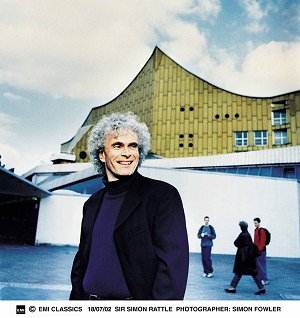S & H Concert Review
Gustav Mahler Symphony Number 2 (Resurrection); Ruth Ziesak (sop), Charlotte Hellekant (mez sop); Philharmonia Orchestra, London Philharmonic Choir; Esa-Pekka Salonen (conductor); RFH, 29th April 2004, (AR)
In recent times Londonís concert halls have been awash with Mahler Resurrections - the Philharmonia Orchestra have played it under Ashkenazy and Kaplan - as well as Haitink with the LPO and Kreizberg with the LSO - so one approached yet another ĎMahler 2í with some trepidation. Mercifully, Esa-Pekka Salonenís inspired interpretation was by no means just another Resurrection: it had a direct, white-hot intensity that gripped a packed RFH from beginning to end. What also made this such an outstandingly well-balanced performance was Salonenís total mastery of the Royal Festival Hallís notoriously dry and dead acoustics. (The planned two year £71 million renovation of the RFH will include "enhancing its acoustics to meet classical music requirements").The Allegro maestoso opened with sharply etched Ďcellos and double basses that created a sensation of nervous tension. Salonenís brisk and incisive conducting was mercifully devoid of the usual fits, starts and distortions of tempi one often hears in this frenzied movement. For example, the coda was taut without the customary slowing down to milk effect; Salonen kept his hands tightly on the reigns, letting Mahler speak for himself, allowing the music to flow beautifully as an organic whole.
Salonen conducted the Andante moderato Ė an Austrian Ländler Ė in a laid back manner with barely perceptible gestures, letting the musicians play with minimal direction. Here the strings had a distant delicacy to them, never sounding overly lush as is frequently the case. Timpanist Andrew Smith opened the Scherzo with his customary precision and attack followed by some gleefully pointed woodwind playing. Here Salonen teased out the sardonic emotions of the music, securing buoyant rhythms and galvanising his forces into producing burlesque sounds.
In the ĎUrlichtí, Swedish mezzo-soprano Charlotte Hellekant was adequate rather than inspired with her low-octane, monotone delivery lacking both depth and breadth. In stark contrast, soprano Ruth Ziesak has a soaring, wide ranging voice, deeply expressive and of exquisite purity. The passages for solo woodwind and off-stage brass can very often sound protracted but under Salonenís disciplined direction this subdued ephemeral section took on a magical radiance. The Allegro energico was just that, with Salonen igniting his forces to explode, the brass and percussion playing with a rare combination of force and refinement, never distorting as can often happen in this section.
Salonen held together the huge last movement with total control, gradually yet inexorably building to a magnificent climax, raising the hall and everyone in it from earth to cosmos. The closing passages were highly concentrated and emotionally intense with the superb London Philharmonic Choir, singing in impeccable German, floating their phrases from a tranquil hushedness to a euphoric blaze. The symphony ended in a torrent of soaring ecstatic sounds, inspiring the audience to respond with enthusiastic applause.
This was an outstanding performance which under Salonenís direction became an ethereal embodiment of Nietzscheís doctrine of the Eternal Recurrence.
Alex Russell
Further Listening
Gustav Mahler, Second Symphony; Heather Harper, Dame Janet Baker, Bavarian Radio Symphony Orchestra, Otto Klemperer: EMI Classics: CDM5668672.

 Return to:
Return to: